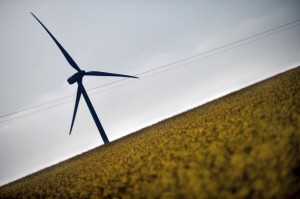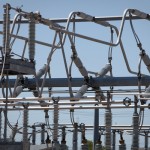As Tax Credit Hangs in the Balance, Texas Sets Another Wind Record

JEFF PACHOUD/AFP/Getty Images
Wind turbines like this one in France are popping up in parts of Texas, but the loss of a tax credit could stall the green energy growth.
Many Texans woke up to a breezy, cool morning today, and when they turn their lights on and start doing their laundry or nuke a breakfast taco, many of them will be doing so with the help of that breeze: wind power.
Texas leads the country for installed wind power, and is one of the largest wind energy producers in the world, with more wind capacity than France, Italy or Great Britain as of the beginning of this year. A few weeks ago, the state set a new record for generation. Nearly 26 percent of the state’s power on the morning of November 10 came from Texas wind power, beating the previous record set in June.
The amount of power generated by wind that morning was 8,521 megawatts, or enough to power some 4.3 million Texas homes during times of average electricity use, according to the Electric Reliability Council of Texas (ERCOT), which manages the grid that supplies much of the state.
“We have surpassed previous wind power records several times this year,” Kent Saathoff, ERCOT’s vice president of Grid Operations and System Planning, said in a statement. “While added capacity is one reason for this growth, experience and improved tools also are enabling ERCOT to integrate this resource into the grid more effectively than ever before.”
Most of that wind power came from wind farms in West Texas, with the rest coming from wind turbines on the Gulf Coast.
ERCOT says that the record day represented 85 percent of all of the wind power capacity in the state. Take the installed capacity in Texas and triple it and you have how much wind power is under review by ERCOT currently. That means that on the right day with the right conditions, over 75 percent of the state’s power could come from wind. ERCOT says that completion of the costly Competitive Renewable Energy Zones (CREZ) transmission project will increase the “ability to move wind power from West Texas to the metropolitan areas where demand on the grid is highest.”
But the future of wind power development in the state faces an imminent threat, as a federal tax credit is set to expire at the end of the year unless Congress renews it. If it does expire and those wind projects under consideration don’t get up and running by January 1, 2013 they won’t get the credit, and are likely to disappear for the time being. Marita Mirzatuny of the Environmental Defense Fund (EDF) notes in an analysis this week that “the expiration of the [tax credit] could not only mean stunting job growth but would also likely create layoffs.”
The tax credit has been around since 1992, and is good for the first ten years of a turbine’s operation, and gives wind energy producers a credit based on how much energy they produce. In Texas’ energy-only, deregulated market, that means that sometimes wind power can be offered into the market at negative prices.
The conservative Texas Public Policy Foundation alleges in a recent report that “the PTC’s current annual cost in Texas alone is approximately $567 million. If continued, the cost of the PTC in Texas would run about $4.1 billion through the 10 years ending in 2015.”
But the effect on power prices is largely restricted to the West Zone of the grid (where most of the state’s wind turbines are). That zone serves West Texas and parts of the panhandle, and the effect on the grid overall is relatively rare.
“The problem with this claim is that it isn’t supported by the facts, and most industry experts agree that the real problem (if you want to call low energy prices a problem) is a combination of a market structure in need of reform and consistently low natural gas prices,” EDF’s Colin Meehan said in a September report. “What this really means is that for 90 percent of the non-wind capacity in ERCOT, they experience negative prices resulting from wind 0.4 percent of the time.”
Yet once those new transmission lines from West Texas are up by the end of next year, it’s possible that the effect of subsidized wind power the market could become worse as that negatively-priced power is expanded into the state’s other energy zones (there are four of them: North, South, East and West), according to a June report by the Brattle Group, a consultant to the Texas Grid.
Or the new lines could actually help with wind power prices. “Sometimes new transmission lines can alleviate the negative pricing phenomenon,” Matthew Wald wrote in the New York Times earlier this fall. “In 2010 in the Chicago area, the occurrence of negative pricing peaked at 3.1 percent of all hours, according to the regional grid operator, the PJM Interconnection. That dropped to 2.1 percent the following year when more transmission capacity was added.”
But more wind power could create some other issues, according to the Brattle report. Wind is a very capricious power, and comes and goes at it pleases. “The risk of sudden reductions in wind output increases the need for operating reserves,” the report says, something that the grid must plan for.
All eyes are now on Congress, which must decide by the end of the year whether to renew the credit or modify it. The conventional wisdom is that after President Barack Obama’s re-election and a near sweep by Democrats in the Senate, the tax credit’s prospects are better than they were a month ago. If it expires wholesale, however, expect to see a negative impact on wind power jobs and generation in Texas and the rest of the county.


